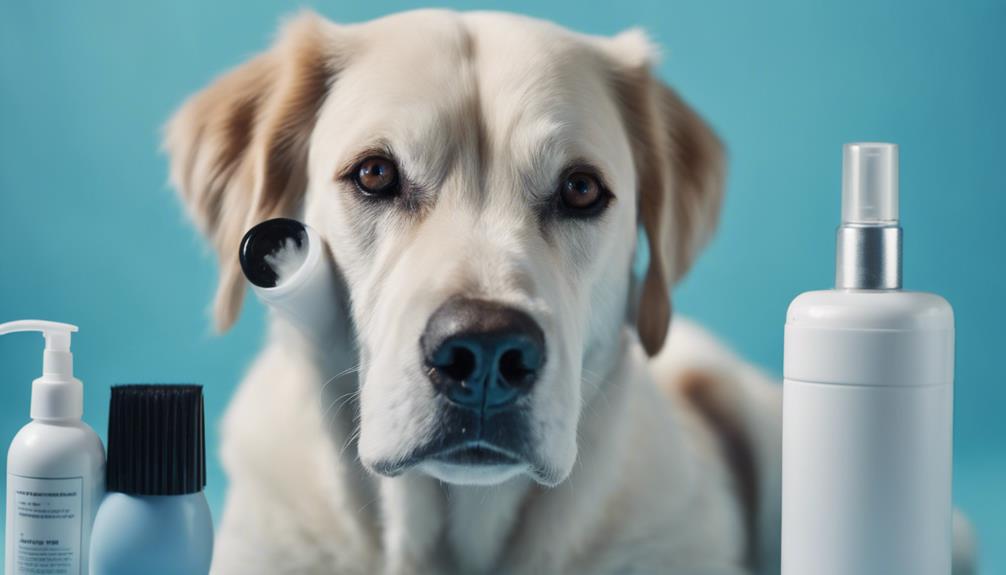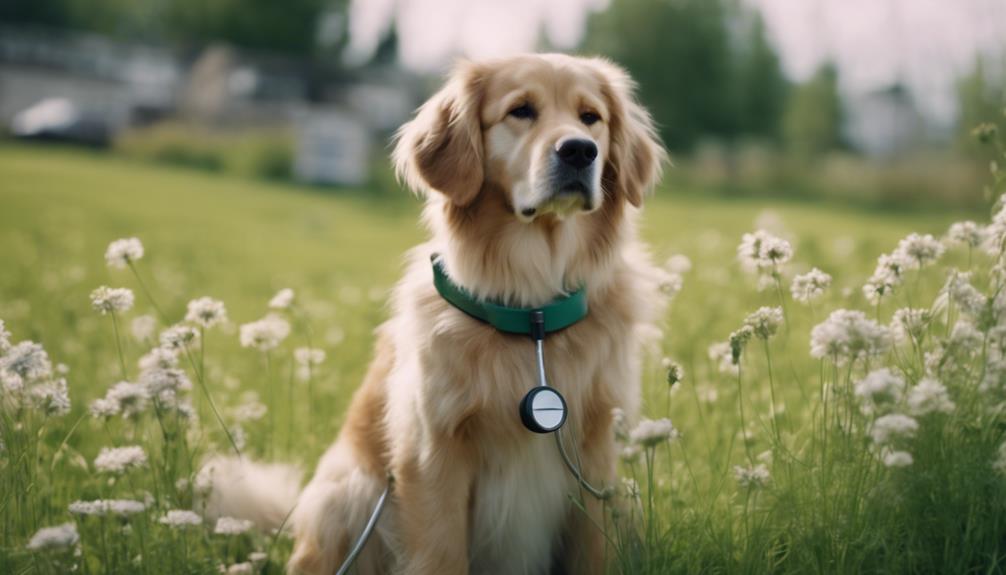Treating Canine Sebaceous Adenitis
- Advertisement -
You're likely seeking a thorough treatment plan to manage your dog's sebaceous adenitis, a rare skin condition that requires a lifelong commitment to alleviate its symptoms and prevent complications. To effectively treat sebaceous adenitis, you'll need to combine oral medications, such as omega fatty acids and systemic retinoids, with topical treatments like shampoos and oil soaks. Regular monitoring is vital to prevent skin infections, which can worsen the condition. A customized treatment plan tailored to your dog's specific needs, along with consistency and early diagnosis, are key to managing sebaceous adenitis successfully. As you explore treatment options, you'll discover more about the therapies and strategies that can help your dog thrive.
Key Takeaways
- Treating sebaceous adenitis in dogs requires a lifelong commitment to managing the condition with a combination of oral and topical therapies.
- Oral medications like omega fatty acids, systemic retinoids, and cyclosporine can help manage the disease, while topical treatments alleviate symptoms.
- Fatty acid products have shown promise in treating sebaceous adenitis, and regular monitoring is crucial to prevent skin infections.
- Combining topical and oral therapies is crucial for alleviating symptoms and promoting skin health, with vitamin A as an adjunct therapy.
- Consistency is key in treating sebaceous adenitis, and a customized plan tailored to a dog's specific needs is crucial for successful management.
Understanding Sebaceous Adenitis
Sebaceous adenitis is a rare skin disease that affects dogs, specifically targeting the sebaceous glands responsible for producing sebum. Sebum is an oily substance that keeps your dog's skin and hair healthy.
When sebaceous adenitis sets in, it destroys these essential glands, leading to a deficiency in sebum production. As a result, your dog's skin becomes dry, flaky, and prone to irritation. Hair follicles are also affected, causing hair loss.
It's important to know that sebaceous adenitis is not contagious and cannot be transmitted between dogs. While the exact cause is unknown, genetic and immune-mediated factors are thought to play a role.
There is no cure for sebaceous adenitis, but treatment options can manage symptoms and improve your dog's quality of life. Your veterinarian can recommend the best course of treatment, which may include topical creams, oral medications, and dietary changes.
Clinical Signs and Diagnosis
Recognizing the clinical signs of sebaceous adenitis is crucial. This condition can manifest in two forms. The long-coated form typically affects breeds like standard poodle, Akita, and Samoyed, and is characterized by skin lesions and hair loss on the head, ear flaps, and muzzle. The short-coated form, commonly seen in breeds like Vizsla and dachshund, is marked by multifocal to coalescing patches of hair loss with scaling.
To diagnose sebaceous adenitis, you need to rule out other conditions like superficial pyoderma, demodicosis, and dermatophytosis. A detailed history and examination are necessary, along with diagnostic tests such as skin cytology, bacterial culture, skin scraping, trichogram, fungal culture, and biopsy for dermatohistopathology. Early lesions show discrete granulomas in areas of sebaceous glands, perifollicular inflammation targeting sebaceous glands, and no involvement of other adnexa.
Common clinical signs of sebaceous adenitis include follicular casts, scaling, and alopecia. A skin biopsy is necessary for diagnosis, but other possibilities must be considered and infections must be diagnosed and treated first. Accurately identifying the cause of seborrhea is vital to ensure the correct treatment is prescribed, as sebaceous adenitis can be mistaken for other conditions. Early diagnosis and treatment can minimize the loss of sebaceous glands and the development of infections, highlighting the importance of prompt veterinary attention.
Treatment Options for Dogs

Treating sebaceous adenitis in dogs requires a lifelong commitment to managing the condition. To develop an effective treatment plan, you'll need to work closely with your veterinarian.
Oral medications can help manage the disease. These may include omega fatty acids, systemic retinoids, cyclosporine, vitamin A, tetracycline, and niacinamide. You may need to try a combination of medications to find the right one for your dog.
Topical treatments can also alleviate symptoms. These include shampoos, humectants, and oil soaks. Fatty acid products have shown promise in treating sebaceous adenitis.
Regular monitoring is crucial to prevent skin infections, which can worsen the condition. Your veterinarian may recommend regular check-ups to adjust your dog's treatment plan as needed.
With lifelong therapy, you can help manage your dog's sebaceous adenitis and improve their hair coat. It may take several months to see significant improvement, so patience is key. By working closely with your veterinarian and staying committed to your dog's treatment plan, you can help them live a comfortable, healthy life despite their condition.
Topical and Oral Therapies
Combining Topical and Oral Therapies to Manage Sebaceous Adenitis in Dogs
To effectively manage your dog's sebaceous adenitis, you'll need to use a combination of therapies. A thorough approach that includes both oral and topical treatments is crucial for alleviating symptoms and promoting skin health.
- Advertisement -
Topical therapies, such as keratolytic shampoos and emollient rinses, can reduce flaking and soothe the skin. They're particularly effective in reducing scaling and inflammation.
Oral therapies play a vital role in managing sebaceous adenitis. Three effective options are:
- Omega-3 fatty acid supplementation: 180 mg per 4.5 kg of body weight can improve skin condition and reduce inflammation.
- Isotretinoin: 1 mg/kg body weight daily has been shown to effectively treat sebaceous adenitis in multiple breeds.
- Cyclosporine: 5 mg/kg body weight daily has been used to treat the condition in dogs.
Additionally, vitamin A can be used as an adjunct therapy to support skin health. Oral antibiotics may be necessary to address secondary bacterial infections, which can occur due to the condition's antimicrobial properties. By combining these therapies, you can effectively manage your dog's sebaceous adenitis and improve their quality of life.
Managing the Condition Successfully

Managing Sebaceous Adenitis in Your Dog
To successfully manage sebaceous adenitis in your dog, you'll need to commit to a long-term treatment plan and regular check-ups with your veterinarian. Since this is an inherited disease, it's crucial to work with your vet to develop a customized plan tailored to your dog's specific needs.
Consistency is key in treating sebaceous adenitis. Topical antimicrobial therapy, often used in conjunction with oral medications like cyclosporine, can help minimize sebaceous gland loss and infections. Additionally, oil soaks, leave-on sprays, and spot-on fatty acid products can provide moisture to the skin and improve its barrier function.
Early diagnosis and treatment are vital in managing this condition. The sooner you start treatment, the lower the risk of severe skin lesions and infections. It's also essential to accurately identify the cause of seborrhea to ensure the correct treatment is prescribed, as sebaceous adenitis can be mistaken for other conditions.
Frequently Asked Questions
How Do You Treat Sebaceous Adenitis in Dogs?
To treat sebaceous adenitis in dogs, a multi-faceted approach is necessary. Start with topical creams to soothe the skin and medicated baths to reduce flaking. Steroid injections can help calm inflammation, while cyclosporine therapy and antibiotic treatment target underlying infections. Regular skin scraping and biopsy testing are crucial to monitor progress. Additionally, consider using topical anesthetics for pain management and make lifestyle changes to reduce stress. By combining these methods, you can effectively manage this chronic condition.
What Shampoo Is Good for Dog's Sebaceous Adenitis?
When selecting a shampoo for your dog with sebaceous adenitis, prioritize gentle, sulfate-free formulas that condition and moisturize the coat. Medicated baths with natural ingredients can calm the skin. Opt for pH-balanced, fragrance-free shampoos that reduce irritation. Look for soothing formulas with anti-inflammatory properties to alleviate symptoms. Shampoos with natural ingredients like aloe vera or oatmeal provide gentle cleansing without stripping the coat of its natural oils.
What Supplements Are Good for Dogs With Sebaceous Adenitis?
Supplements can help alleviate skin issues in dogs with sebaceous adenitis. Omega-3 fatty acids, specifically EPA and DHA, have anti-inflammatory properties. These can be found in fish oil supplements. Vitamin E, an antioxidant, reduces oxidative stress and inflammation. Probiotics support the immune system, while turmeric curcumin has potent anti-inflammatory effects. Antioxidant blends can also provide extensive benefits. Niacinamide and zinc, found in herbal remedies, promote skin health and wound healing. Before adding supplements to your dog's regimen, consult with a veterinarian to determine the best course of treatment.
What Dog Food Is Good for Sebaceous Adenitis?
When selecting a dog food for Sebaceous Adenitis, prioritize options that promote skin health. Fish oil and omega-rich diets reduce inflammation, while grain-free formulas can help alleviate symptoms. Limited ingredient diets with novel protein sources like venison or duck can be beneficial. Opt for single-source protein and anti-inflammatory effects to support skin health. Moisture-rich foods with soothing ingredients and hypoallergenic recipes can also provide relief. Avoid common allergens and irritants to minimize skin reactions.
In summary
Treating sebaceous adenitis in dogs requires a combination of topical and oral therapies. By using the right treatments, you can alleviate painful, crusty lesions and improve your dog's coat health.
Topical treatments can help soothe the skin and reduce inflammation. Oral medications can address underlying issues and prevent further skin problems. Working together, these treatments can transform your dog's dull, brittle coat into a shiny, healthy one.
Remember, every treatment is a step towards your dog's comfort and well-being. By following a consistent treatment plan, you can help your dog feel better and look better.
- Advertisement -

